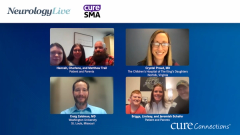
Genetic Testing for SMA in Children and Adolescents
Crystal Proud, MD, and Craig Zaidman, MD, discuss the necessity and urgency of genetic testing for SMA in children and adolescents.
Episodes in this series

Crystal Proud, MD: We have great options for testing. Maybe we can ask Briggs’ parents: Did you have a blood test, a cheek swab, a muscle biopsy, or something else to test your DNA?
Jeremiah: It was the blood test.
Lindsay: No, it wasn’t. It was a cheek swab.
Jeremiah: OK. Never mind.
Briggs: I got the cheek swab.
Crystal Proud, MD: You got the cheek swab. That’s a newer technology, Briggs, which is pretty cool that we can test pieces of your DNA by taking a little Q-tip and rubbing it on the inside of your cheek. That has made it so much easier to pursue some of this testing. Hannah, do you remember how you were tested?
Charlene: She had the blood test.
Crystal Proud, MD: Hannah had the blood test done. Some of our patients are much older than you both. Years ago, before we had easy access to DNA testing, they had to have their muscles looked at under a microscope by something called a muscle biopsy. I’m glad that isn’t the case for both of you and that we now have easier ways of testing. Dr Zaidman, maybe you can speak to some of the ways we pursue testing these days.
Craig Zaidman, MD: The exam and the history, of course. I want to mention that when you have a child who’s losing skill, that’s an emergency too, whether it’s SMA or not. If you’re referring to somebody like us and you have a child who’s declining, that requires a phone call, in my opinion.
Crystal Proud, MD: I agree.
Craig Zaidman, MD: We’ll get those patients in also right away. As far as other testing that’s commonly done, routine blood tests are commonly performed. It’s amazing how many people forget you can check a CK [creatine kinase] in a child. That’s an easy test that can be done prior to referral. We do what’s called an EMG [electromyography]—a nerve conduction study, which is an electrical test on the nerves and muscles. In my experience, this can be easily done in most children without any sedation. It occasionally needs light sedation. But that requires a specialist. That requires somebody who’s experienced with that test, particularly in children, which has its own nuances.
Genetic testing is increasingly available, and I’m using it all the time. There are a number genetic panel tests that are often free for the patient, including SMA testing, which can be ordered in a way that’s free for the patient. We’re doing that routinely. More rarely, we’ll take pictures of muscles either with an ultrasound or an MRI machine. As mentioned, you can perform a muscle biopsy or a nerve biopsy. That covers it.
Let me mention 1 other thing, Dr Proud. Because we’re talking about SMA in particular, when a child is diagnosed with SMA, either by newborn screen—the more common way—or out in the community in an older child, that’s just the beginning. Some of the therapies that we have require additional blood testing to see if you’re a candidate for it. Some of the therapies have a size or age limit before they can be used. We’re talking about children who are identified by newborn screening in particular. They will need additional blood testing as part of their initial evaluation to determine the right course of treatment for them.
Crystal Proud, MD: That’s a good reminder that the genetic testing we have is available at no cost. This used to be huge barrier for many of our patients and physicians trying to seek confirmatory testing for the patients they were evaluating. Like you, I send it quite frequently, because if I suspect it, I test for it. If it’s anywhere on the list of possibilities, I test for it. I’m very glad that comes at no cost to the family.
Transcript edited for clarity.
Newsletter
Keep your finger on the pulse of neurology—subscribe to NeurologyLive for expert interviews, new data, and breakthrough treatment updates.





















